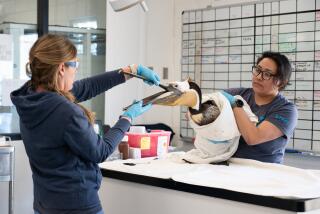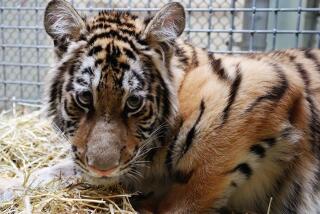SIMI VALLEY : Volunteer Program Saves Injured Birds
- Share via
Uttering piercing cries, a red-shouldered hawk struggled for freedom Friday in its caretaker’s leather-gloved hands but then fluttered to the ground and hopped crow-like across the dusty ground in Ojai.
The bird had spent two months recovering from a broken wing in the care of the Ventura County Raptor Rehabilitation Program.
The rescue operation for injured birds of prey was founded last year under the auspices of the Moorpark College Exotic Animal Training and Management Program and operates with a permit from the state Department of Fish and Game.
About 55 hawks, owls, falcons and vultures have received care this year, with about 70% making sufficient recovery to be released into the wild.
Jerry Thompson, one of the coordinators of the program, estimated that one-third of his patients are gunshot victims in spite of the fact that raptors have protected status under California law. Others have broken wings by flying into power lines or are injured in fences. Occasionally, a bird is struck by a car and left stunned next to the road. Birds come to the rehab program through the county Animal Regulation Department, Moorpark College, local vets and private citizens.
The small hawk released Friday had one of many unexplained injuries treated in the garage of Thompson’s Simi Valley home. Birds receive free veterinary care from Angeles Animal Hospital in Simi Valley or Conejo Valley Veterinary Clinic in Thousand Oaks.
Funded by donations and assisted by eight trained volunteers, Thompson tends 15 birds of prey in various stages of recovery.
Half the size of its red-tailed cousins, this red-shoulder was a female about 5 years old. Hawks mate for life, and Thompson said it was possible that the bird might still find its mate and nest, although it is late in the season.
A former falconer with more than 20 years experience in the sport, Thompson’s love of raptors was apparent as he prepared to release the bird. “I like your attitude,” he said to the hawk, as it scanned surrounding trees with the fierce gaze typical of its kind.
The release itself was not dramatic, although characteristic of a bird restrained in a dark box for six weeks to allow its wounds to heal. If exposed to light or given too much room to move, a wild bird may compound its injuries trying to escape. Keeping a hawk passive can be a challenge, but it is a key aspect in early rehabilitation, he said.
During the last two weeks of its convalescence, the hawk lived in one of four flight cages in Thompson’s back yard, where it proved able to fly and hunt live game.
But the bird seemed disoriented when at last permitted its freedom. After fluttering to the ground, it was recaptured by Pete Trim, co-coordinator of Raptor Rehabilitation. The second time, the bird skittered over a fence into the riverbed itself.
“You prefer to see them take off and fly to a high place, but this isn’t unusual,” Thompson said. “This bird is strong and still fully wild. It often takes 24 hours to readjust to freedom.”
More to Read
Sign up for Essential California
The most important California stories and recommendations in your inbox every morning.
You may occasionally receive promotional content from the Los Angeles Times.










